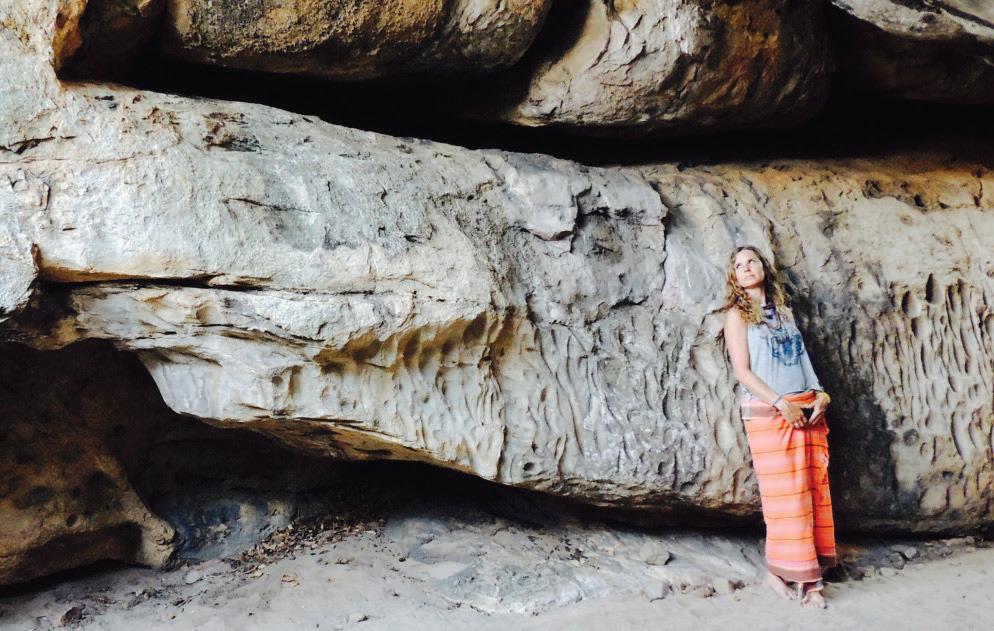
4 minute read
Sacred Sites
Mountains of the Gods
Tsodilo Hills
By Louise Clarke
The first rays of light of the satiated African dawn were just beginning to touch the gauze window of our tent. The air was fresh, crisp and full of birdsong. I opened my eyes and there they were - the Mountains of the Gods.
In the ancient San Bushman language the greeting of ‘good morning’ translates as ‘Are you awake?’ For a moment I lay there, gazing out at the mountains, magnificent in the morning light, wondering whether I was in fact awake or still dreaming.
Twice I have journeyed to the far remote north western corner of Botswana to experience this astounding place rising up from the Kalahari Desert. It is - to me - the most special sacred site I have yet had the privilege to visit.
Tsodilo Hills, as mentioned in my last Sacred Sites column around Informed Consent, is a UNESCO World Heritage site famous for having the highest concentration of stone paintings in the world. For this reason it is commonly known as the ‘Louvre of the Desert’. Yet, that’s not all… It is also the place where the world’s oldest ritual is believed to have been performed in honour of the python 70,000 years ago, predating archaeological record in Europe by 30,000 years!
Tsodilo Hills are made up of four hills named Aba (Father) Thai (Mother) and Dama (child), and another hill to the north. The San believe that this northern hill is the first wife of Aba who fled when Aba left her for a younger woman. Dama is the child of the Father and Mother mountains.
Driving out there in the desert in open game viewing vehicles in 40 degree heat is an experience all on its own. As you approach the mountains there is a very tangible mystical ambiance to the place that seems to sparkle in the clear, arid atmosphere and as you arrive there can be no doubt - this is indeed the resting place of the gods.
With us were local guides of San and Bantu origin, and it’s fascinating to hear the different cultural accounts of the history of this ancient place. The site is vast and takes many full days to explore the thousands of rock paintings in no less than 600 sites depicting animals, geometric patterns, humans and handprints. There are also depictions of whales and penguins on those rock faces out there in the desert!
To get to the ritual site of the Serpent Cave to the north of Mother hill takes hours of hiking and climbing in that desperate heat. Just arriving there is an initiation in itself!
Along the way our San guide collected dry grass for the ceremony to be performed in the cave and we drank like



animals, lips to pool, from a sacred spring at the foot of the hill.
Words cannot describe the feeling of looking down from the entrance of the cave and being confronted with a massive stone serpent two meters high and six meters long, carved from the back wall of the cave. Zulu Wisdom Keeper, Credo Mutwa, maintains that the great rock serpent is a representation of the Milky Way and a conduit to the star realms and beings. He says that for many thousands of years pilgrims would gather in the cave and utter prayers to the serpent for protection, fertility and abundance.
In 2006 Sheila Coulson of the University of Oslo along with a team of scientists and students, in collaboration with the University of Botswana discovered thirteen thousand artefacts in the cave - mostly spearheads and tools associated with the carving of the snake.

Interestingly, the entire length of the snake is carved with smooth indentations representing scales, and apparently, in the light of a fire, the snake appears to be moving.
Incidentally, according to one creation myth in San lore, mankind descended from the python and the ancient, arid stream beds around the hills are said to have been created by the python as it circled the hills in its incessant search for water.
We spent many hours in the cave. Our San guide made a fire the ancient way by rubbing sticks together. We held ceremony and gave thanks to the Spirit of the Land. That night, under the great Serpent in the Sky, the Milky Way, we lit another sacred fire uniting many cultures from around the world. And perhaps the greatest awakening of all was to experience the timeless bushman song in a moonless Kalahari night.

Louise Clarke Exploring sacred sites in Africa and walking as an art of healing.
Image Credit: Louise Clarke










